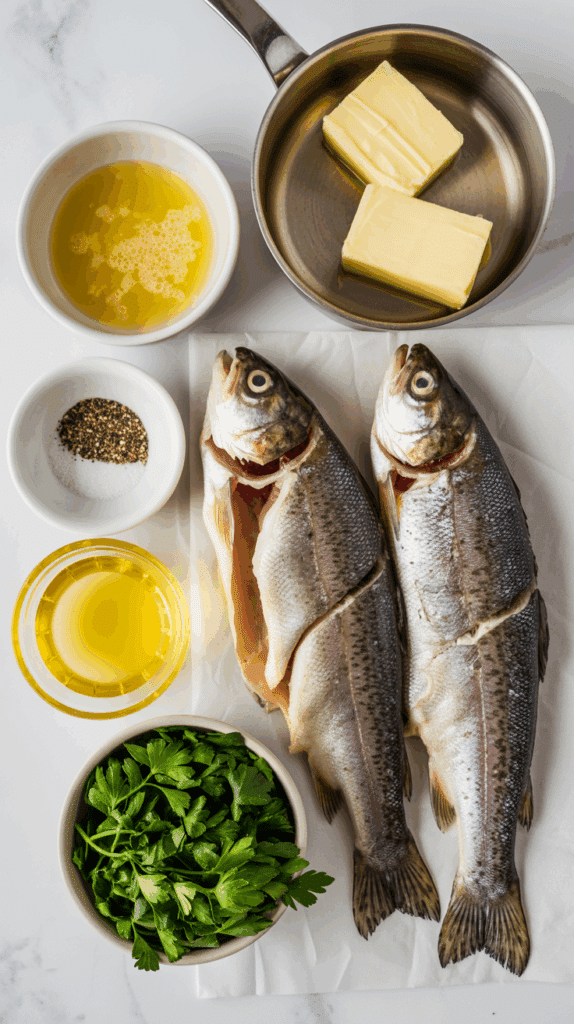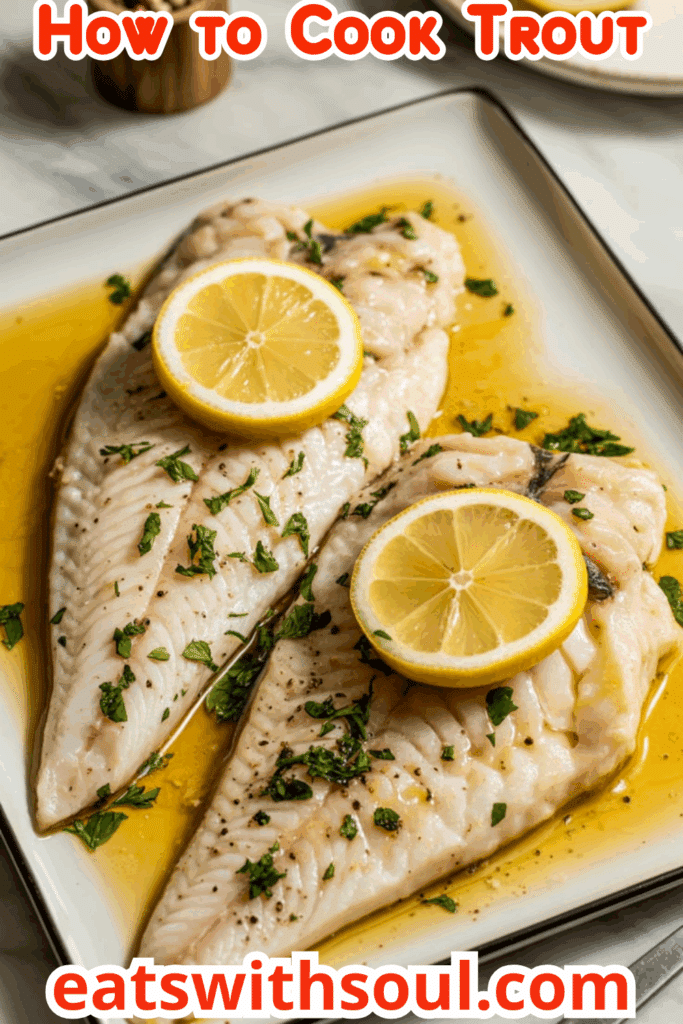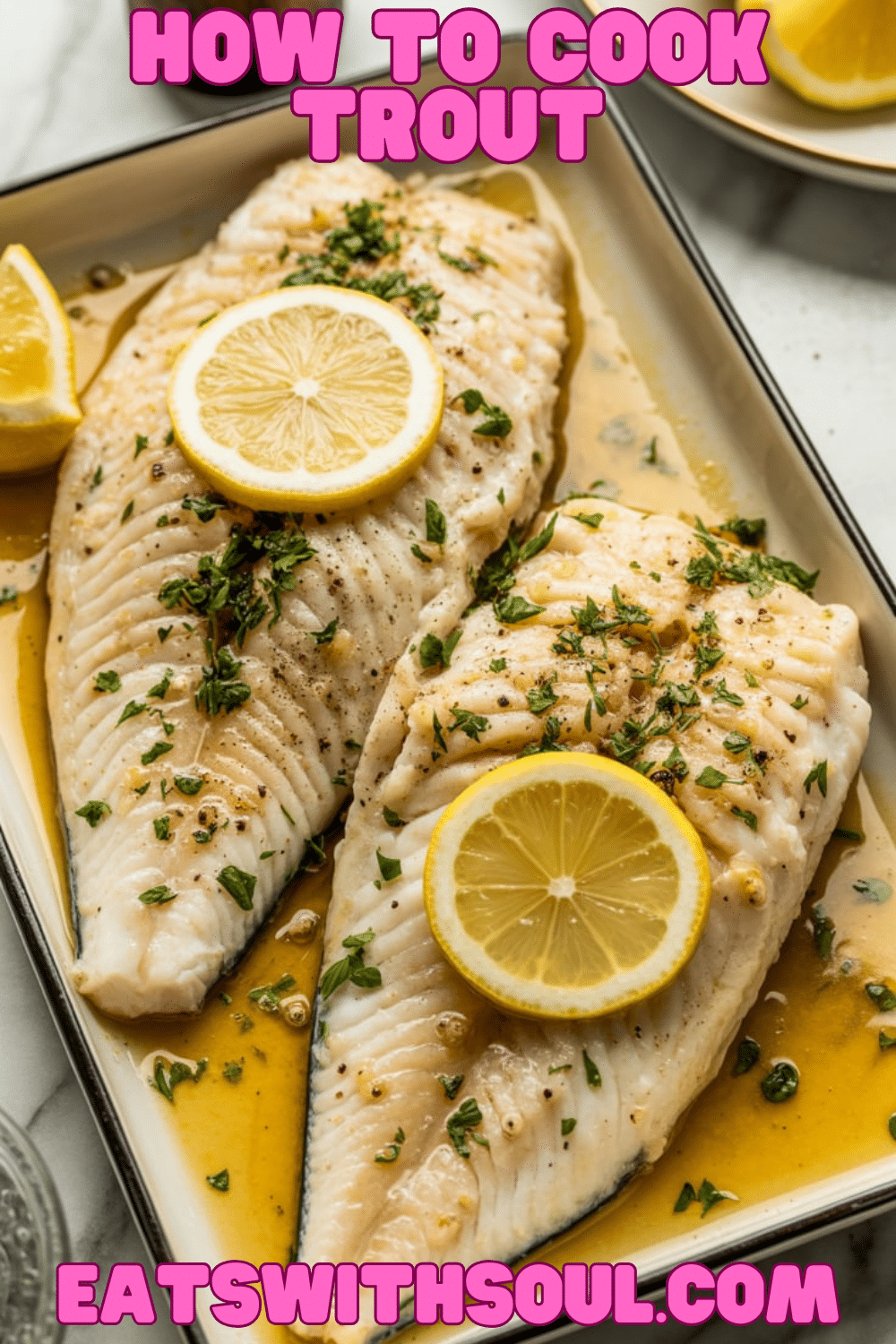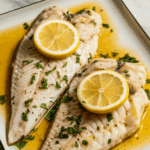Introduction & Inspiration
There’s something wonderfully elegant yet incredibly simple about perfectly cooked fresh fish, and this Broiled Trout with Brown Butter Lemon-Parsley Sauce is a shining example! Imagine delicate, flaky whole trout, butterflied for quick cooking, seasoned simply, and broiled to tender perfection. It’s then napped with a luscious sauce made from butter cooked until nutty and golden brown, brightened with fresh lemon juice, and studded with fresh parsley. It’s a classic preparation that tastes like it came from a fine dining restaurant but is surprisingly easy to make at home.
My inspiration for this recipe comes from loving those timeless French bistro dishes where simple, high-quality ingredients are allowed to shine. Browning butter (beurre noisette) creates an incredible depth of nutty flavor that beautifully complements delicate fish like trout, and the lemon and parsley add essential brightness.
This dish is perfect for a quick weeknight dinner that feels special, an elegant lunch, or anytime you want to enjoy fresh fish prepared in a truly delicious way. It comes together in minutes! It is a perfect recipe for fish lovers.
Nostalgic Appeal / Comfort Factor
Simply prepared fresh fish, like pan-fried or broiled trout, often evokes feelings of wholesome, satisfying meals – perhaps reminiscent of fishing trips, coastal dining, or classic European cuisine. The brown butter and lemon sauce, similar to a classic Meunière sauce, brings a touch of familiar, slightly luxurious comfort.
This recipe delivers that comforting satisfaction with a touch of elegance. The nutty aroma of browning butter, the delicate flavor of the trout, and the bright finish of lemon and parsley create a dish that feels both classic and incredibly appealing.
It’s a timeless preparation that is both comforting in its simplicity and sophisticated in its flavor. A perfect dish to savor fresh fish.
Homemade Focus
This recipe is all about achieving restaurant-quality results through simple, homemade techniques using fresh ingredients. You’re starting with whole (butterflied, deboned) trout, seasoning it simply, and cooking it quickly under the broiler. The star homemade component is the brown butter lemon-parsley sauce, created by carefully cooking butter until golden and nutty, then finishing it with fresh lemon and parsley.
The homemade focus lies in mastering the art of browning butter perfectly (it’s easy once you know what to look for!) and cooking the delicate trout just until flaky. These simple homemade steps make all the difference in the final flavor and texture.
It celebrates how fresh ingredients and fundamental cooking techniques can combine to create an exceptionally delicious and elegant meal with minimal fuss. The homemade brown butter sauce is incredible.
Flavor Goal
The primary flavor goal is delicate, flaky trout with a clean taste, beautifully complemented by a rich, nutty, and aromatic brown butter sauce that’s brightened by tangy lemon and fresh parsley.
The trout itself, seasoned simply with salt and pepper and a touch of the melted butter, should taste fresh and moist. The brown butter sauce is key: it should have a distinct nutty, toasted aroma and flavor – not burnt, but beautifully golden. The fresh lemon juice cuts through the richness of the butter, adding essential acidity, while the fresh parsley provides herbaceous brightness and color.
The overall experience should be a harmonious blend of tender, flaky fish and a luscious, nutty, bright sauce – a sophisticated yet simple delight. A perfect balance between flavour and texture.
Ingredient Insights
- Whole Trout (Butterflied and Deboned): About two 8-ounce trout. “Butterflied” means the fish is split open like a book, and “deboned” means the main bones have been removed, making it easy to eat. This preparation allows for quick, even cooking under the broiler. Skin is typically left on one side.
- Butter (Unsalted or Salted): The star of the sauce! ¼ cup (1/2 stick) is used. Browning it develops a deep, nutty flavor. If using salted butter, you might need less added salt for seasoning the fish.
- Salt and Freshly Ground Black Pepper: For seasoning the trout.
- Freshly Squeezed Lemon Juice: Absolutely crucial for brightening the brown butter sauce and cutting through its richness. Use fresh lemons!
- Fresh Flat-Leaf Parsley (Chopped): Adds fresh, herbaceous flavor and color to the finished sauce.
Essential Equipment
- Saucepan (Small to Medium, preferably light-colored): For making the brown butter sauce. A light-colored pan helps you monitor the browning process accurately.
- Baking Sheet: Large enough to hold the butterflied trout flat.
- Aluminum Foil: For lining the baking sheet for easy cleanup.
- Oven with Broiler: The cooking method for the trout.
- Fish Spatula (Recommended): Helpful for gently removing the delicate cooked trout from the baking sheet.
- Knife & Cutting Board: For chopping parsley, juicing/slicing lemon.
- Measuring Cups & Spoons:
- Whisk (Optional): For the sauce, though stirring usually suffices.
Ingredients
(Original recipe yields 2 servings)
Trout:
- ▢ 2 (8 ounce) whole trout, butterflied and deboned
- ▢ Salt and freshly ground black pepper to taste
- ▢ Approx. 1 teaspoon melted butter (from the ¼ cup total, for drizzling)
Brown Butter Lemon-Parsley Sauce:
- ▢ ¼ cup butter (1/2 stick)
- ▢ 2 tablespoons freshly squeezed lemon juice
- ▢ 2 tablespoons chopped fresh flat-leaf parsley

Step-by-Step Instructions
1. Prepare Brown Butter Base (Initial Step):
- Gather all your ingredients.
- In a small to medium-sized saucepan (preferably with a light-colored bottom so you can see the color change), melt the ¼ cup of butter over medium-low to medium heat.
- Continue to cook the butter, swirling the pan occasionally. It will foam up, then the foaming will subside, and you’ll start to see golden brown milk solids forming at the bottom of the pan. The butter will smell nutty and toasted. This browning process might take about 1-3 minutes after it fully melts – watch it carefully as it can go from perfectly browned to burnt very quickly!
- As soon as the butter is golden brown and smells nutty, immediately turn off the heat. Set this brown butter aside for now. (Recipe implies some of this initial melted butter is used to drizzle on fish, then rest is reheated. Alternatively, make all sauce at end).
2. Prepare and Season Trout:
- Line a baking sheet with a piece of aluminum foil.
- Place the butterflied trout onto the foil-lined baking sheet, opening them up so the skin sides are down and the flesh is exposed.
- Drizzle each trout fillet with about 1/2 teaspoon of the melted (or browned) butter from your saucepan.
- Season the trout generously with salt and freshly ground black pepper.
3. Preheat Broiler:
- Adjust an oven rack so it is about 5 to 6 inches below the broiler heat source.
- Preheat the oven’s broiler on the HIGH heat setting.
4. Broil the Trout:
- Place the baking sheet with the prepared trout under the preheated broiler.
- Broil for 2 to 3 minutes, or until the trout is opaque, flakes easily with a fork, and is just barely firm to the touch. Trout cooks very quickly under the broiler, so watch it closely to prevent overcooking.
- Carefully remove the baking sheet from the oven once the trout is cooked.
5. Finish Brown Butter Lemon-Parsley Sauce:
- Return the saucepan containing the remaining browned butter to the stovetop over medium-high heat. (If you didn’t reserve any, or if it solidified too much, you can just gently re-warm all the brown butter).
- Stir in the 2 tablespoons of freshly squeezed lemon juice and the 2 tablespoons of chopped fresh parsley.
- Bring this butter sauce just to a boil (this will happen very quickly), whisking or stirring to combine all the ingredients. Cook for just a few seconds once boiling.
6. Serve:
- Carefully transfer the broiled trout fillets to serving plates.
- Immediately spoon the hot Brown Butter Lemon-Parsley Sauce generously over the trout.
- Serve at once and enjoy!

Troubleshooting
- Butter Burning (Instead of Browning): Heat too high under saucepan, or not watched carefully. Brown butter needs medium-low to medium heat and constant attention once it starts to color. If it burns (black specks, acrid smell), discard and start over.
- Trout Sticking to Foil: Foil wasn’t greased, or trout skin (if present but recipe says removed) stuck. Lightly greasing foil or using non-stick foil can help. Drizzling butter on fish first also helps.
- Trout Overcooked/Dry: Broiled too long, or too close to broiler element. Trout is delicate and cooks very fast. 2-3 minutes is often all it needs. Check for flakiness early.
- Trout Undercooked: Not broiled long enough. Ensure it’s opaque and flakes easily.
- Sauce Too Oily/Separated: Less common with simple brown butter sauce, but could happen if butter was very hot and lemon juice very cold causing separation. Whisk well when combining.
Tips and Variations
- Watch Brown Butter Carefully: It can go from perfectly nutty and golden to burnt in seconds! Use a light-colored pan to monitor the color. Remove from heat as soon as it’s amber/golden brown with a nutty aroma.
- Broiler Vigilance: Fish cooks extremely quickly under the broiler. Stay close and check frequently.
- Fish Doneness: Trout is cooked when it flakes easily with a fork and the flesh is opaque. Internal temperature should be around 135-145°F.
- Add Capers: For a classic Trout Meunière Amandine feel (without almonds here), add 1-2 teaspoons of drained capers to the brown butter sauce along with the lemon and parsley.
- Toasted Almonds: Sprinkle toasted slivered almonds over the sauced fish for Trout Amandine.
- Different Herbs: Fresh dill or chives would also be lovely in the sauce instead of or with parsley.
- Pan-Frying Option: Instead of broiling, you can pan-fry the butterflied trout. Melt butter in a skillet, season trout, place skin-side down (if it had skin) first, cook for 2-3 minutes per side until done. Then make sauce.
- Whole Trout (Not Butterflied): If using whole, non-butterflied trout, broiling time will be longer (4-6 minutes per side depending on thickness), and pan-frying is also a great option.
Serving and Pairing Suggestions
- Serve Immediately: Best enjoyed hot, straight from the broiler with the warm sauce.
- Classic Sides: Pairs beautifully with simple steamed new potatoes (tossed in butter and parsley), rice pilaf, quinoa, or roasted asparagus or green beans.
- With Crusty Bread: For soaking up any leftover delicious brown butter sauce.
- Elegant Meal: Perfect for a light yet sophisticated dinner.
- Wine Pairing: A crisp, dry white wine like Sauvignon Blanc, Pinot Grigio, or an unoaked Chardonnay complements the delicate fish and bright sauce.
Nutritional Information
(Note: Estimated, per 8-ounce trout serving with sauce. Variable based on exact trout size and butter amount.)
- Calories: 350-450
- Fat: 25-35g (Butter and natural fish oils)
- Saturated Fat: 12-18g
- Cholesterol: 100-140mg
- Sodium: 300-500mg+ (depending on added salt and if salted butter is used)
- Total Carbohydrates: 1-3g
- Dietary Fiber: <1g
- Sugars: <1g
- Protein: 30-40g
Simple Broiled Trout with Brown Butter Lemon-Parsley Sauce
Learn How to Cook Trout perfectly under the broiler! This easy recipe features butterflied trout with a rich, nutty brown butter, lemon, and parsley sauce. Quick and elegant!
Ingredients
(Original recipe yields 2 servings)
Trout:
- ▢ 2 (8 ounce) whole trout, butterflied and deboned
- ▢ Salt and freshly ground black pepper to taste
- ▢ Approx. 1 teaspoon melted butter (from the ¼ cup total, for drizzling)
Brown Butter Lemon-Parsley Sauce:
- ▢ ¼ cup butter (1/2 stick)
- ▢ 2 tablespoons freshly squeezed lemon juice
- ▢ 2 tablespoons chopped fresh flat-leaf parsley
Instructions
1. Prepare Brown Butter Base (Initial Step):
- Gather all your ingredients.
- In a small to medium-sized saucepan (preferably with a light-colored bottom so you can see the color change), melt the ¼ cup of butter over medium-low to medium heat.
- Continue to cook the butter, swirling the pan occasionally. It will foam up, then the foaming will subside, and you’ll start to see golden brown milk solids forming at the bottom of the pan. The butter will smell nutty and toasted. This browning process might take about 1-3 minutes after it fully melts – watch it carefully as it can go from perfectly browned to burnt very quickly!
- As soon as the butter is golden brown and smells nutty, immediately turn off the heat. Set this brown butter aside for now. (Recipe implies some of this initial melted butter is used to drizzle on fish, then rest is reheated. Alternatively, make all sauce at end).
2. Prepare and Season Trout:
- Line a baking sheet with a piece of aluminum foil.
- Place the butterflied trout onto the foil-lined baking sheet, opening them up so the skin sides are down and the flesh is exposed.
- Drizzle each trout fillet with about 1/2 teaspoon of the melted (or browned) butter from your saucepan.
- Season the trout generously with salt and freshly ground black pepper.
3. Preheat Broiler:
- Adjust an oven rack so it is about 5 to 6 inches below the broiler heat source.
- Preheat the oven’s broiler on the HIGH heat setting.
4. Broil the Trout:
- Place the baking sheet with the prepared trout under the preheated broiler.
- Broil for 2 to 3 minutes, or until the trout is opaque, flakes easily with a fork, and is just barely firm to the touch. Trout cooks very quickly under the broiler, so watch it closely to prevent overcooking.
- Carefully remove the baking sheet from the oven once the trout is cooked.
5. Finish Brown Butter Lemon-Parsley Sauce:
- Return the saucepan containing the remaining browned butter to the stovetop over medium-high heat. (If you didn’t reserve any, or if it solidified too much, you can just gently re-warm all the brown butter).
- Stir in the 2 tablespoons of freshly squeezed lemon juice and the 2 tablespoons of chopped fresh parsley.
- Bring this butter sauce just to a boil (this will happen very quickly), whisking or stirring to combine all the ingredients. Cook for just a few seconds once boiling.
6. Serve:
- Carefully transfer the broiled trout fillets to serving plates.
- Immediately spoon the hot Brown Butter Lemon-Parsley Sauce generously over the trout.
- Serve at once and enjoy!
Recipe Summary and Q&A
Summary: This recipe for Simple Broiled Trout involves making a brown butter base by melting butter in a saucepan until golden and nutty. Butterflied and deboned whole trout are placed skin-side down on a foil-lined baking sheet, drizzled with a little of the melted butter, seasoned with salt and pepper, and broiled quickly (2-3 minutes) until opaque and firm. The remaining brown butter is then reheated with fresh lemon juice and chopped parsley, brought to a boil, and spooned over the broiled trout before serving immediately.
Q&A:
- Q: What does “butterflied and deboned” trout mean?
- A: Butterflied means the fish has been split open along the belly (or back) and laid flat like an open book. Deboned means the main spine and rib bones have been removed, making it much easier to eat. Your fishmonger can often do this for you, or you can find it pre-prepared.
- Q: How do I know when the butter is properly browned and not burnt?
- A: As the butter melts and cooks, the milk solids will sink to the bottom and start to turn golden brown. The butter will foam, then the foam will subside, and it will take on an amber or light golden-brown color and have a distinctly nutty, toasted aroma. If the solids turn dark brown or black, or it smells acrid, it’s burnt and should be discarded. Use a light-colored pan to see the color change easily.
- Q: Can I use trout fillets instead of whole butterflied trout?
- A: Yes, trout fillets would work well. Adjust broiling time based on their thickness – they will likely cook even faster than butterflied whole trout, possibly in just 1-2 minutes per side (if flipping) or 2-3 minutes total.
- Q: What if I don’t have fresh parsley?
- A: Fresh parsley adds significant brightness. If you must use dried, use about 1-2 teaspoons and add it to the butter with the lemon juice to allow it to rehydrate slightly. However, fresh is strongly recommended for this classic sauce. Fresh dill would be a good alternative.

